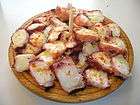Ribeira Sacra (DO)
| Wine region | |
 | |
| Type | Denominación de Origen |
|---|---|
| Country | Spain |
Ribeira Sacra is a Spanish Denominación de Origen (DO) (Denominación de Orixe in Galician) for wines located in the south of the province of Lugo and in the north of the province of Ourense, in Galicia, Spain. It extends over the territories of 17 different municipalities that conform a zone and entity called Ribeira Sacra, which could be translated as "Sacred Shore". The vineyards are planted on the steep slopes of the valleys and canyons of the rivers Miño and Sil. The area acquired official Denominación de Origen status in 1997.
Three types of varietal wine are produced: red Mencía, white Albariño and white Godello.
History
It is generally believed that grape growing and wine production were introduced to the area by the ancient Romans. It is said that the legendary spiced Vinos de Amandi were shipped to Rome along with the lampreys fished out of the river Miño, to be served at the table of the emperor.
It is believed that Ribeira Sacra takes its name from 18 monasteries and hermitages that were founded in the early Middle Ages between the 8th and 12th centuries and which are located in the inaccessible river valleys. It was the monks who replanted the vineyards for their own consumption and maintained the grape-growing and wine-producing tradition until modern times. The most important monasteries are:
- San Pedro de Bembibre
- Taboada dos Freires
- San Paio de Diomondi
- Santo Estevo de Ribas de Miño
- Santa María de Pesqueiras
- Montederramo
- San Pedro de Rocas
- Ferreira de Pantón
- San Paio de Abeleda
- Santa Cristina de Ribas de Sil
- San Estevo de Ribas de Sil
Geography
The area is divided into five sub-zones, each with a different micro-climate, but in general all the soils are alluvial over a slate based subsoil.
Moving from north to south, the sub-zones are: Chantada and Amandi (in the municipality of Monforte de Lemos), Ribeiras do Miño (the largest sub-zone), Ribeiras do Sil-Ourense, and lastly Quiroga-Bibei.

Climate
The climate in Ribeira Sacra DO is more continental than Atlantic, and has long hot summers and cool autumns. However, rainfall is high (around 800 mm per year).
The sub-zones on the river Miño have more rain (900 mm) than the ones on the river Sil (700 mm). In general, the Miño area has a more Atlantic climate whereas the Sil area is more continental.
Winds can be very strong as they are funnelled by the shape of the valleys.
Grapes
The authorized white varieties are: Albariño, Godello, Treixadura, Loureira, Torrontés and Dona Branca, though the first three are the most predominant.
The authorized red varieties are: Mencía, Grand noir, Brancellao and Merenzao.
The vineyards are planted on terraces (known as bancadas) in the narrow valleys of the rivers and are characterized by the production of grapes with a very concentrated flavor. The terraces are usually very small, making it impossible to mechanize the vineyard activities, such as pruning and harvesting. Access is often very difficult and sometimes only possible from the river.




